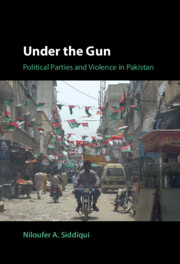Book contents
- Under the Gun
- Under the Gun
- Copyright page
- Dedication
- Contents
- Figures
- Tables
- Acknowledgments
- Abbreviations
- 1 Introduction
- 2 The Logic of Party Violence
- 3 Setting the Stage
- 4 Who Owns the Guns? the Muttahida Qaumi Movement and Violence in Karachi
- 5 The Pakistan Peoples Party and the Gangs of Lyari, Karachi
- 6 Allying with Militants? the Pakistan Muslim League-Nawaz and Sectarian Groups in Punjab
- 7 An Ideology of Nonviolence? the Awami National Party in Khyber Pakhtunkhwa
- 8 Party Violence in Comparative Perspective
- 9 Conclusion
- Appendix
- Bibliography
- Index
3 - Setting the Stage
Violence, State Capacity, and Political Representation in Pakistan
Published online by Cambridge University Press: 18 November 2022
- Under the Gun
- Under the Gun
- Copyright page
- Dedication
- Contents
- Figures
- Tables
- Acknowledgments
- Abbreviations
- 1 Introduction
- 2 The Logic of Party Violence
- 3 Setting the Stage
- 4 Who Owns the Guns? the Muttahida Qaumi Movement and Violence in Karachi
- 5 The Pakistan Peoples Party and the Gangs of Lyari, Karachi
- 6 Allying with Militants? the Pakistan Muslim League-Nawaz and Sectarian Groups in Punjab
- 7 An Ideology of Nonviolence? the Awami National Party in Khyber Pakhtunkhwa
- 8 Party Violence in Comparative Perspective
- 9 Conclusion
- Appendix
- Bibliography
- Index
Summary
Chapter 3 provides an overview of the political climate in Pakistan, setting the stage for the empirical cases which follow. It provides brief but essential context on political representation, state capacity, and manifestations of violence in Pakistan. I explain in more detail the manner in which state institutions, including the police and military, interact with political parties and local strongmen to determine the cost and incentive structure parties encounter. I focus on two types of political landscapes in Pakistan, shared sovereignty and multiple competing sovereigns, and introduce the particular dynamics of political representation and violence in each. In doing so, I highlight the important role played by such structural factors as land and socioeconomic inequality, ethnic demographics, urban sprawl, and the availability of arms and ammunition. I then provide brief overviews of the four main political parties discussed in this book, with a focus on the parties’ organizational structures and how these structures came to be.
- Type
- Chapter
- Information
- Under the GunPolitical Parties and Violence in Pakistan, pp. 52 - 72Publisher: Cambridge University PressPrint publication year: 2022

